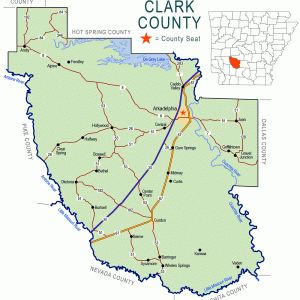calsfoundation@cals.org
Dobyville (Clark County)
Dobyville is a small community in Clark County located about eight miles northwest of Gurdon (Clark County) and four miles northeast of Okolona (Clark County).
The earliest settlers in the area include Henry and Joel Robinson and Thomas Franklin. They obtained 560 acres in 1837, but little additional information is known about the men.
James and Ann Sloan moved to the area in the late 1830s. James obtained almost 400 acres of land, and the couple had at least four sons and two daughters. By the 1850 federal census, James Sloan held real estate worth more than $1,200 and owned twelve enslaved people. By 1860, he owned fourteen slaves and had more than $3,500 of real estate and more than $14,000 of personal property.
The large Doby family arrived in the area around 1860 and began acquiring land just before the Civil War, with William Doby receiving a land patent for forty acres in early 1861. He obtained another forty acres in 1882, and his son John obtained eighty acres to the north in 1885.
William Doby and his wife, Altona, lived in the area with their three children by 1860. Sources indicate that other members of the extended family lived nearby, including Joseph and Margaret Doby. Margaret died in 1860 and is the first known burial in the Dobyville Cemetery. The cemetery continues to be used in the twenty-first century.
The Carolina Presbyterian Church began operations in the community in 1861. A permanent building that was constructed in 1867 near the cemetery served the church for almost a century. Support from the Presbyterian Church in Arkadelphia (Clark County) helped staff the pulpit until the arrival of Samuel Orr as the first full-time pastor in 1869. Orr also operated a general store and cotton gin. The Dobys were prominent members of the congregation, and some members from other Protestant denominations, including Baptists and Methodists, attended the church because it was closer than their own churches.
Members of the church helped found the Presbyterian Church in Gurdon in the 1890s, and in 1915, the Carolina Presbyterian Church became the Dobyville Presbyterian Church to better represent the area the congregation served. With a dwindling congregation, the Ouachita Presbytery met at the church in 1956 to discuss disbanding. The remaining members of the church voted not to disband as long as a single member remained alive. Services were no longer regularly held at the church, but funeral (or “homecoming”) services were held several times a year. The last surviving member of the church died in 1968. Although the building was vandalized over the next several decades, it was still standing in 1992 when an extensive history of the church was written. A modern metal shed with several pews was later placed at the approximate site of the former church.
Joseph Doby operated a store in the community while also farming, and after the Civil War, other businesses such as cotton gins and general stores began opening in Dobyville. A school was initially housed in the Carolina Presbyterian Church. A log schoolhouse opened in the community in 1882.
A post office was established in 1879 and operated until 1914 in a store operated by the Doby family. The area was then served by the post office in Okolona. In 1902, the community was connected to the Arkadelphia Telephone Company, linking the settlement to other locations in the county. Rural electrification reached the community in 1940.
With the paving of Arkansas Highway 51 in the 1920s, Dobyville was bypassed on the major route between Okolona and Arkadelphia. This led to the eventual depopulation of the community, with many residents moving to Gurdon and other nearby towns. The Dobyville School consolidated with the Shady Grove School located at nearby Bethel (Clark County) in 1926. The Shady Grove School consolidated with the Okolona District in 1929. In the twenty-first century, the community is part of the Gurdon School District.
The community remains isolated and heavily forested, accessible from State Highways 51 and 53 via Dobyville Road. Few residences remain, although multiple hunting camps and poultry operations are located nearby.
For additional information:
Patterson, Robert H. “Memoirs of Robert H. Patterson.” Clark County Historical Journal (Fall 1982): 114–141.
Richter, Wendy, et al. Clark County, Arkansas: Past and Present. Arkadelphia, AR: Clark County Historical Association, 1992.
David Sesser
Southeastern Louisiana University
 Clark County Map
Clark County Map 




Comments
No comments on this entry yet.